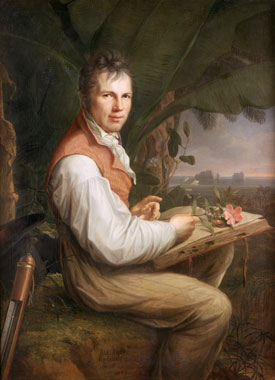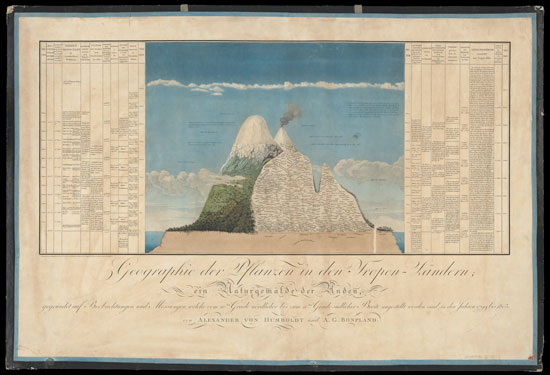The centennial of Alexander von Humboldt’s birth was celebrated across the world in 1869. Around that time, the famed globe-trotting explorer and natural systems scientist was memorialized in numerous statues, and many institutions, geographic features, and communities—and almost a U.S. state—would come to bear his name.
Wherever he traveled, Humboldt went to great lengths and personal and monetary expense to conduct detailed geophysical and ecological measurements.
But through much of the ensuing century and a half, Humboldt’s global celebrity and status as a scientific luminary diminished, the latter as scientists increasingly eschewed the naturalistic approach of Humboldt and others. Today, many in the United States and elsewhere have only recently rediscovered his ideas and the prominent role he played in establishing the modern natural sciences.
Wherever he traveled, Humboldt went to great lengths and personal and monetary expense to conduct detailed geophysical and ecological measurements. He also excelled at synthesizing the wide range of observations he collected. Although his brother Wilhelm is credited with establishing the modern university model combining research and education, Alexander is reasonably attributed as a founding father of systems science, which characterizes species and processes, for example, in terms of their interconnections rather than in isolation from each other.
This year, 14 September marks Humboldt’s 250th birthday, offering an opportunity to revisit and celebrate his life and contributions to science. AGU is commemorating Humboldt with a new theme in Geochemistry, Geophysics, Geosystems, as well as a Union session at the Centennial Fall Meeting in San Francisco this December.
Life of an Explorer

Alexander von Humboldt was born in Berlin to an established Prussian family in 1769, 2 years his brother Wilhelm’s junior. Their father died when Alexander was 10, and their mother remained only a distant presence, with tutors likely instilling the adventurous spirit that Alexander displayed early on. He pursued an eclectic mix of studies, including languages, anatomy, geology, and astronomy at universities in Hamburg, Jena, and Freiberg. After settling on a mining degree and graduating from the School of Mines in Freiberg in 1792, Humboldt was appointed an inspector of mines near Bayreuth in Bavaria.
In addition to establishing a vocational training program and support network for miners, this appointment led to his first scientific study, in 1793, on vegetation in mines. This work brought him to the attention of the prominent poet Johann Wolfgang von Goethe, who was also a natural historian, and led to a life of science and intellectual exchange. Set free of his day job when he inherited his mother’s fortune in 1796, Humboldt set off to explore the world at the turn of the 18th century. Much of his subsequent life happened on the road and in the salons of Paris and involved discussions with many of the leading intellectuals of the time, from Friedrich Schiller and Louis Agassiz to Henry David Thoreau and Charles Darwin.
Humboldt made a number of important contributions across natural disciplines, establishing the field of biogeography and helping establish ecology and conducting meticulous measurements that informed sweeping theories, such as on links between topography and vegetation. In his life, he undertook two major expeditions, observations from which drove most of his discoveries.
The first—and more significant of the two—brought him to the Americas from 1799 to 1804 on a trip that would eventually change prevailing views of Latin America and its connections to the rest of the world. From its inception, this journey was different from other exploration efforts at the time: It was solely geared toward science.

Humboldt had his sights on data, looking to measure altitudes, temperatures, and the magnetic field; to draw geological cross sections; and to collect rocks, plants, and animals, all while trying to understand the culture of local societies. Most geographers at the time were more interested in defining political boundaries, giving little consideration to Earth’s relief and morphology and often injecting heavy doses of subjective interpretation. Humboldt instead focused on nature and data, and his approach was original: By properly reporting reliefs on maps, he could describe the changing landscape and biogeosphere.
Among other contributions, Humboldt placed Andean flora and fauna into distinct climatic and topographic contexts and described human impacts on climate change as potentially affecting the evolution of society. Humboldt also established links with various notable figures from west of the Atlantic, including future revolutionary leader Simón Bolívar and, on a visit to the United States, President Thomas Jefferson, a fellow scientist who is said to have called Humboldt “the most scientific man of his age.”
After his return to Europe, Humboldt spent much of the rest of his life placing the findings from his Latin American voyage into a global environmental context.
After his return to Europe, Humboldt spent much of the rest of his life placing the findings from his Latin American voyage into a global environmental context. His three volumes entitled Relation historique du voyage aux régions équinoxiales du nouveau continent (1814–1825) represent the first report of that expedition. He then expounded on this work in the five-volume Kosmos, which was based on a series of highly successful public lectures in 1827–1828.
Humboldt’s second major expedition was to Russia in 1829, where he reached as far as the Altai Mountains. It represented a compromise after many failed attempts to venture farther to India and elsewhere in Asia. The immediate scientific insights from this expedition were comparatively limited, although he could claim the discovery of diamonds in the Urals and a number of geographic corrections.
A Revolutionary Thinker
By nature, Humboldt was collaborative and open to sharing data. And he continually revised and updated his own published works over his lifetime, emblematic of his interconnected and dynamic view of knowledge and its dissemination.
Reading Alexander von Humboldt, we notice that his approach to science was revolutionary in many ways. First, Humboldt displayed an impressively high level of precision and accuracy in his data collection, paying particular attention to make sure measurements and sample locations were properly georeferenced. He was thus able to create the first global geomagnetic and temperature maps, paving the way to the establishment of general relationships.

Another fundamental aspect of his approach was his search to understand connections between natural processes and their feedbacks. For example, Humboldt analyzed spatiotemporal distributions of and possible connections between earthquakes and volcanic eruptions in great detail, in search of a general theory that could explain their individual causes as well as possible triggering processes. Quantitatively establishing such links in terms of stress triggering of volcanic conduit systems remains an unsolved question in geodynamics and volcanology.
Humboldt appears to have much preferred Paris over Berlin for most of his life, although he ended up being employed by the Prussian court. He died in Berlin in 1859 nearly penniless but as one of the most famous scholars in the world. A German foundation in Humboldt’s name and spirit was established soon after and to this day supports academics worldwide. Grants are given in the humanities and natural sciences for research in Germany and related collaborations abroad. (Both of the authors were lucky to have been Humboldt Foundation scholarship beneficiaries.)
Contrary to the standard in modern scientific literature, Humboldt mixed travel narrative and descriptions of his emotional responses to natural experiences with discussions of his measurements and the theories he derived from them.
Humboldt appears to have been an overbearing talker and somewhat self-obsessed, yet he was also unselfish in his support of early-career scientists. He shared his data and samples freely and tried to establish an international and open network of scientists driven by a respect for human rights and equality. Contrary to the standard in modern scientific literature, Humboldt mixed travel narrative and descriptions of his emotional responses to natural experiences with discussions of his measurements and the theories he derived from them. Humboldt wrote that “Nature herself is sublimely eloquent. The stars as they sparkle in firmament fill us with delight and ecstasy, and yet they all move in orbit marked out with mathematical precision.”
High-quality data and the search for a physical unifying theory represent the foundation of Alexander von Humboldt’s innovative and creative scientific approach. The special theme in Geochemistry, Geophysics, Geosystems and the upcoming Union session at the Fall Meeting will celebrate Humboldt’s scientific discoveries. More importantly, we hope to build on his vision for understanding the Earth system as a whole in an open, diverse, and collaborative environment.
For those interested in learning more about Alexander von Humboldt, we recommend the brilliant reevaluation of his life offered in Andrea Wulf’s biography, The Invention of Nature: Alexander von Humboldt’s New World (Vintage, 2015). This has more recently been joined by a beautifully illustrated graphic novel, The Adventures of Alexander von Humboldt (Pantheon Graphic Library, 2019) by Wulf and Lillian Melcher.
Author Information
Thorsten W. Becker ([email protected]) and Claudio Faccenna, Jackson School of Geosciences, University of Texas at Austin
Citation:
Becker, T. W.,Faccenna, C. (2019), The scientist who connected it all, Eos, 100, https://doi.org/10.1029/2019EO132583. Published on 11 September 2019.
Text © 2019. The authors. CC BY-NC-ND 3.0
Except where otherwise noted, images are subject to copyright. Any reuse without express permission from the copyright owner is prohibited.

